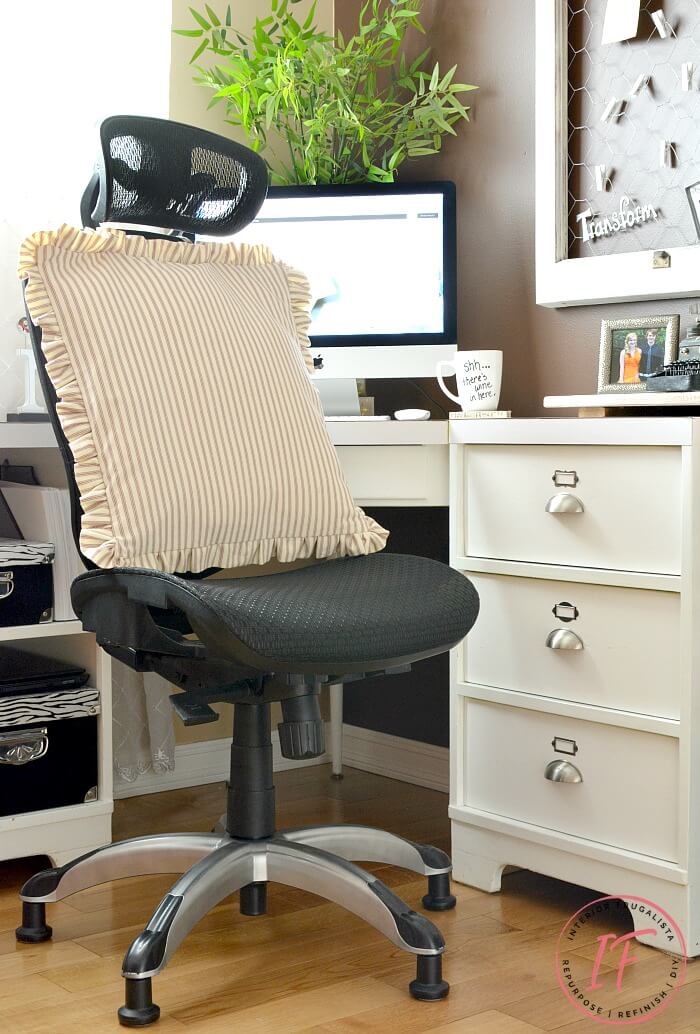Recycled Ticking Fabric Office Chair Pillow
How to make a farmhouse-style office chair bolster pillow from a recycled ticking fabric slipcover to provide extra back support for us short-statured folks!
You can sew this pillow cover with novice sewing skills and it doesn't require sewing a zipper. This DIY ruffled pillow is made with a simple envelope-style closure. While I include a tutorial on how to make the ruffle, you could use a readymade fabric ruffle instead.
Farmhouse-Style Office Chair Pillow DIY
If you are vertically challenged like me, I'm sure you can relate to the struggle of finding an office chair (or any chair for that matter) where you can scoot all the way back and have your feet touch the ground. Not good when your business requires a lot of time spent at a computer.
Depending on the height of your desk, lowering the chair may not be an option either, especially if you have a laptop computer. This handmade office chair bolster pillow scoots you forward so your feet touch the ground and provides much-needed back support.
Before making the office pillow, I was using a small pillow behind my back but it was a nuisance because it constantly shifted and fell to the floor every time I stood up. This pillow has ties that wrap behind the headrest to hold it in place and can be adjusted accordingly.
The pillow cost me absolutely nothing to make by recycling an old red ticking fabric armchair slipcover.
I've been on a mission to use every stitch of the slipcover fabric to make something useful. So far I've made these pretty ticking fabric Christmas ornaments, these unique ticking fabric pumpkins, and this ticking fabric heart wreath.
But if you don't have a slipcover, you could use a pillow cover, recycled clothing fabric, or fabric remnants that you have on hand. Or you could easily adapt any 20-inch pillow cover by simply adding tiebacks to hold it in place on your office chair.
How To Sew An Envelope-Style Office Chair Pillow
As mentioned earlier, we will not be using a zipper closure for the pillow cover but rather a simple envelope-style closure. This makes it easy to remove the pillow to wash the pillow cover.
Cutting Pillow Fabric
The instructions for this office pillow are based on a 20-inch pillow form, adjust your measurements according to the size of your pillow form.
Helpful Tips
- For a fuller pillow cut the fabric the same size as the pillow form without adding a seam allowance.
- If you plan on recycling an old slipcover like I did, try to incorporate the parts of the fabric with finished seams. The less sewing involved the better!
I was thrilled to find a long piece of the slipcover with a finished seam that I could use for both the front and back of the pillow cover.
- Cut the fabric for the front of the pillow 20 x 20-inches.
- With envelope-style pillows you want the back two pieces to overlap one another by at least four inches.
- My readymade option is 14-inches long which provides a four-inch overlap on both pieces.
- Cut the width of the back pieces 20-inch wide like pictured below.
I'll be salvaging the tiebacks from the old slipcover (pictured below) to hang the bolster pillow around the headrest of the office chair. This saved a lot of time from having to make tiebacks.
DIY Bolster Pillow Ruffle
Cut long strips of fabric (make sure the pattern is going the same direction) into 4-inch wide strips. You will need enough to make a 160-inch long strip of fabric plus an extra 10-inches for seam allowances.
Sew the 4-inch strips together like pictured below. Cotton ticking fabric is prone to fraying so you may want to serge the seams. If you don't have a serger, use the serging stitch or elastic stretch stitch on your sewing machine to prevent the edges from fraying as pictured below.
Once you have your 160-inch strip of ruffle fabric sewn, fold it in half lengthwise and press with an iron. While you have the iron heated, now is a good time to press any wrinkles in the other fabric pieces too.
This next step for making the ruffle can be tedious so you may want to do it while watching your favorite show on television.
- Measure the ruffle every 40-inches (which equals double the width of each side of the pillow cover) and mark it with a pin.
- Starting at one end hand sew a basting stitch (like pictured below) with a needle and thread up to the first 40-inch mark.
- Make sure to leave long strands of thread on each end.
- It's important that there are no knots in the thread so it gathers easily.
- Slowly and carefully pull the thread on either end to gather the fabric until it measures 20-inches long (the length of one side of the pillow) as pictured below.
- Tie the threads so they don't unravel.
- Gather the next 40-inches of fabric the same way.
- Continue this step until you have an 81-inch long ruffle plus an extra inch for a 1/2-inch seam allowance.
- Sew the two ends of the ruffle together, making sure the ruffle isn't twisted.
Attach Ruffle To Pillow
If you are an avid sewer and have no problems sewing the ruffle at the same as stitching the pillow cover together, then you'll want to skip ahead to the next section. But if you are a novice like me, then the instructions below are an easier way to sew the ruffle onto the pillow.
- Pin the raw edges of the ruffle to the raw edge of the front piece of the pillow cover.
- With the stitch length set to 4 on your sewing machine, baste stitch the ruffle with a 1/2-inch seam allowance, pivoting the needle at each corner.
TIP - How To Sew Corners
- When coming to a corner, stop stitching 1/2-inch from the corner (same distance as the seam allowance).
- Make sure the needle is in the down position poking in the fabric.
- Lift the pressure foot, pivot the fabric 90 degrees, and continue stitching.
- Check to make sure the ruffle on both sides of the corner is still facing towards the center of the pillow cover so you don't accidentally stitch over it.
Now that we have the ruffle sewn onto the front piece of the pillow cover, we'll work on the two back pieces for the envelope closure. You can see in the photo below that I didn't take my own advice and iron first.
Stitching The Envelope Pillow Cover
- Lay the front piece with the right side facing up and the ruffles pointing toward the center of the pillow.
- Pin the raw edge of the tiebacks 6-inches from each corner so they will hang on each side of the headrest on the office chair.
- Point the ties inward towards the center of the pillow.
- Lay one of the back pieces with the good side facing down and the finished seam towards the center of the cover.
- Pin the raw edges together.
- Lay the second piece over the previous one, again with the finished seam towards the center, and pin the raw edges together.
- Sew a 5/8-inch seam allowance around the entire pillow, pivoting the needle at the corners.
- Take your time as there will be a lot of bulk.
- Make sure the ruffles are lying flat toward the center, especially around the corners where there is more bulk.
- You may need to turn the balance/handwheel on the sewing machine to manually stitch over the bulky areas so the needle doesn't break.
Turn the pillow cover right side out, pushing the corners out with the end of a wooden spoon. Slip a 20-inch pillow form on the inside of one-half of the pillow cover like pictured below.
Fold the other half of the pillow cover over the pillow form and you are ready to hang it on your office chair.
Adjust the height of the pillow to your liking, wrap the ties around the headrest, and tie them together.
I hope you found the tutorial easy to understand. If not, don't hesitate to ask in the comment section or press the contact me tab at the top of the blog to send an email. I'm happy to help.
Thanks for stopping by the Interior Frugalista today! I hope you were inspired by this office chair bolster pillow idea.
For more DIY pillow ideas and tutorials see my Drop Cloth Fabric Rosette Pillow or Pearl Brooch Pillow Cover.
Almost all of our DIY ideas have step-by-step tutorials so why not get your budget DIY on and subscribe. You can also find us on Pinterest, Facebook, Instagram, and YouTube.
If you enjoyed this farmhouse-style ticking fabric office chair pillow, I'd be so thankful if you shared it with a friend and pinned it to your favorite board on Pinterest.
I share my projects at these inspiring link parties.



















I read your whole post, laughing, wondering how you were 1" taller on a good day. Great tutorial!
ReplyDeleteI'm the Queen of Slouch most days! LOL I'm glad you enjoyed the tutorial Sandi 😊
DeleteYour office looks amazing and I love this idea Marie! We bloggers do their fair share of writing/sitting so I'm sure this will make things more comfy... and great tutorial btw! xo
ReplyDeleteOh it really is a back saver, Denise. I LOVE my new office pillow and I'm no longer thinking about replacing the chair. Glad you like the tutorial too. Have a great weekend!
DeleteI have pinned this and am definitely making this. I sit all day at the computer or sewing machine and my back and shoulders feel it! Saw you on Snickerdoodle!. PS. Love the colors. Thanks for the post!
ReplyDeleteYou're most welcome! So glad to hear you found this post helpful and plan to make a pillow for yourself. Especially considering you are a gal who knows how to sew! Wishing your back and shoulders some relief. Thanks for stopping by and the pin 😊
DeleteWhat a brilliant idea. I'm not height challenged :D but two of my co-workers are. They'll love this idea and the chairs in the office are almost exactly like your Marie.
ReplyDeleteI hope your co-workers like this idea, Michelle and thank you so much for sharing it with them! xo
DeleteMarie this is such a great solution. I too am vertically challenged and have the same problem. I never get to rest my back in the chair. I even need a pillow in the car to give me height so I can see out the window.
ReplyDeleteGirl, then you need one of these! Seriously, I haven't been getting the lower back pain I used to have when sitting at my computer. I LOVE my new pillow!
DeleteThe chair looks so much nicer with the fabric cushion. The all black chairs are functional but not attractive at all. As I am tall I don't need the boost, but this cushion is nice just for the decor aspect as well.
ReplyDeleteI think so too, Leanna! While the intention was to make it for back support, I really like how it dresses the office chair. While my office is predominantly black & white, the red ticking fabric picks up the red in my antique bookcase which is situated on the wall behind my desk.
DeleteLove this bolster pillow, Marie... and you did a wonderful tutorial, as well. Makes it easy for those that don't sew a lot, that's for sure!
ReplyDeleteThank you Julie, and I'm so glad you liked the tutorial. It's always a stuggle whether I covered all the bases in a way that is understandable when writing them.
Delete